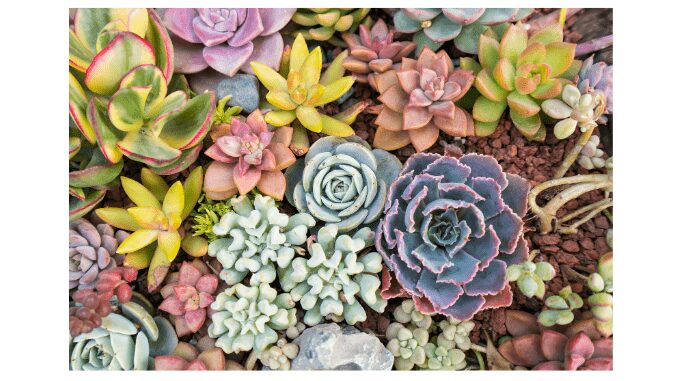Know in one minute about low light succulents
|
Introduction
A succulent is any kind of plant that can store lots of water in its various organs like stems, roots, or leaves. These plants are popular as ornamental plants because they don’t need much care as they are drought resistant. Succulent grows in bright light but some succulents can tolerate medium or low light to flourish well. The following articles is all about types of low light succulents.
This plant is best for modern interior decoration themes, collectors, and landscapers.
Different types of low light succulents
1. Snake Plant
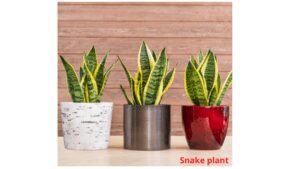
The snake plant (Sansevieria trifasciata) is the most famous succulent that is easy to grow, very hardy, and has a long lifetime. It is very adaptable and grows in low light. These plants are recommended by NASA because it absorbs much household toxic pollutant and converts them to harmless substances. Moreover, unlike other plants, this releases oxygen into the air at night and also can eliminate the bad odor of the room (1).
Common name
Mother-in-Law’s tongue, Bowstring-hemp, Bird’s Nest Sansevieria, Hahnii, Jinn’s tongue, bowstring hemp, Devil’s tongue, Snake’s tongue, Saint George’s sword
Origin
West Africa and Asia
Botanical description
Snake plants have long, flat, and slightly windy green leaves that point upwards. The leaves are mostly green, but some varieties feature a yellow border. These thick fleshy leaves are 3-4 feet tall and up to 3 inches across (2).
How to take care
This plant needs low maintenance they can in any conditions, from dark to bright, and tolerate neglect. Given the proper conditions, this plant may survive year after year and can grow up to five feet tall.
Light
This plant grows well in bright indirect light and may range from low to medium. Although they tolerate low light, not grow as quickly as it does in the bright sun. Bright light brings out the true color in their leaves.
Soil
Well-drained sandy soil is best, to avoid root rot of these plants.
Water
This plant requires water when the top inch of soil is dry and reduces watering in the winter. Water thoroughly, then allows the soil to dry between watering.
This plant doesn’t like too much water because overwater can kill the plant.
Temperature and Humidity
The ideal temperatures required for healthy growth is 55°F-90°F (12°C-33°C). Fiddle leaf fig plants will suffer when exposed to temperatures below 50°F (10°C)
Fertilizer
Fertilize about once a month with a liquid fertilizer during the growing season. Suspend fertilizing during the dormant winter period.
Repotting
This plant is slow-growing and likely to be a little pot bound so does not require repotting often. However, if they grow big enough the repotting should be done in the spring.
How to propagate
The snake plants can be easily propagated during repotting, offset that emerge from the soil can remove and potted independently.
Propagation by leaf
Take the 2 to 3-inch pieces of the leaf and place them in the soil to allow it to grow new roots.
2. Panda plant (Kalanchoe tomentosa)
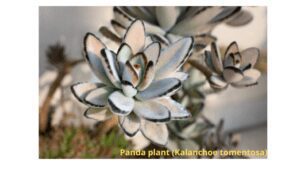
Panda plant (family Crassulaceae) is an attractive, perennial, succulent medicinal herb. These plant leaves are used in folk medicine for the treatment of fever, infections, rheumatism, and skin diseases. Panda plants contain bufadienolides, triterpenoids, and flavonoids which inhibit the growth of cancer cells (3).
Common name
These fuzzy succulents go by the names Panda Plant, Donkey Ears, and Pussy Ears. It is also known by a chocolate soldier, cocoon plant, velvetleaf kalanchoe, white lady, mother of thousands, and mother of millions
Origin
Madagascar
Botanical description
This plant is popular for the gorgeous, furry texture of its leaves. Furry texture is mainly due to the white tiny hairs in them which make them soft and velvety to touch. The leaves are thick and have dark reddish-brown markings on the margins which darken with age. These plants can be reached about 1.5 feet in height and easily thrive in low light.
Flower
This plant produces bell-shaped flowers at the tips of the branch but only in its natural habitat. They barely blossom when kept indoors (4).
How to propagate
Panda plants can propagate simply by taking a leaf from the plant in spring or summer and replant it in sandy potting soil. Make sure to allow the leaf-cutting to dry for at least a week before repotting it again.
How to take care
This plant requires low maintenance and care is very easy, this plant needs watering, only when its soil gets completely dry.
Light
Panda plants love bright light, but can also tolerate indirect light or even low light. This plant grows best in a south-facing or east-facing window when kept in the room.
Temperature and Humidity
The ideal temperatures required for healthy growth is 60°F-75°F (15°C-24°C) with normal room humidity.
Water
This plant can survive in very little water as it is well adapted for a dry environment. Therefore if you are watering this plant make sure that you give plenty of water but not overwater it.
But yes after that should wait until the top soils get dry. Suspend watering during the dormant winter period.
Soil
Well-drained sandy soil is best, to avoid root rot of these plants.
Fertilizer
Fertilize about once a month with a water-soluble fertilizer during the growing season (spring to summer).
Pruning
Pruning is necessary to maintain their size (short), and encourage new leaves to grow.
Repotting
Repotting of the panda plants should be done every 2 years because it is a slow grower.
3. Jade plant (Crassula ovata)
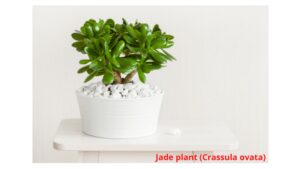
Jade plant (Family- Crassulaceae) is very popular, auspicious, and also known as a good luck plant. Jade plants can tolerate low light and are easy to grow indoors. It is an ideal housewarming gift and wedding gift bonsai plant with thick, woody stems and branches. Jade plant benefits are very easy to maintain, purify the air, can increase indoor humidity, and last for years (5).
Common name
Friendship plant, Lucky Plant, Money plant, Penny Plant, Dollar Plant, Tree of Happiness, Money Vine, Fortunate Plant, Baby Jade, Dwarf rubber plant, Chinese rubber plant, Japanese rubber plant, and Cauliflower Ears,
Origin
This plant is native to South Africa and Mozambique as well as grown in Europe and America for over 100 years
Botanical description
Height
It can grow up to 1-3 m.
Leaves
The leaf is thick, shiny smooth, and egg-shaped with green to red (direct sun) in color.
Flower
This plant produces white or pink star-like flowers with a faint sweet scent in early spring but rarely blossoms indoors (6).
How to propagate
Jade plants can be easily propagated using stem cuttings or a single leaf. These have to dry in a sunny spot for a few days until to form a callous. Place them in fast-draining soil and wait for roots to develop.
How to take care
Temperature
Jade plant prefers daytime temperatures of 65-70 °F during the day and 50-55 °F at night.
Light
This plant needs bright, unfiltered light but can tolerate low light. They are best indoors with a sunny window or south-facing windows. But make sure to keep outside at least once a week in full sun for better growth.
Water
This plant requires a moderate amount of water but only when the top of the soil is dry in the summer and spring season
Soil
Well-drained humus-rich soil is best and should be changed at least every 2 to 3 years.
Fertilizer
Fertilize the plant with a low nitrogen fertilizer solution, once a month during the growing season.
Zebra Plant (Haworthiopsis attenuata)
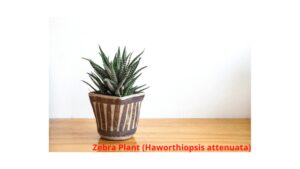
Zebra plant (Family: Asphodeliaceae) is slow-growing and doesn’t need much supervision. It is characterized by pointy leaves which are the same as aloe and zebra-like stripes, also known as zebra cactus. This plant grows well in poor lighting conditions for some time but they need bright indirect light for best growth and produce offsets readily.
Common names
star window plant, zebra cactus, pearl plant, cushion aloe
Origin
Southern Africa
Botanical description
This plant contains yellow and green, fleshy leaves that appear horizontally on the foliage of the plant or form a rosette. These leaves are also covered with white streaks, giving them a zebra-like resemblance. It can grow up to 6 inches tall only. It produces an offset in clump form which is easily divided and forms a new plant. This plant produces bell-shaped, white with green vein flowers in the spring and summer months but only outdoors.
How to propagate
There are 3 ways to propagate zebra plant
From Offsets
A mature healthy plant will eventually produce plantlets up through the soil. These offsets can separate from the mother plant and replant it in potting soil.
From seeds
This plant can also be grown from seed by sowing the seeds in spring in well-drained soil.
From leaves
Zebra plants can be propagated using leaves and replant it in potting soil. Before replanting, wait for a few days to allow it to callus formation over the cut surface and then place it on the soil to root.
How to take care
Light
This plant grows in low light but works best in a bright environment. Zebra plants lean towards the light source in a low light place, it is best to rotate it. Rotation of this plant at least once a week is preventing it from getting asymmetrical.
Water
It requires watering only when the top two-thirds of the soil is dry, also removing excess water. Reduce watering during the dormant winter period.
Soil
Use well-drained potting soil-based potting for best growth.
Fertilizer
This plant is slow growing so doesn’t require a lot of nutrients. Fertilize only once with a liquid fertilizer from spring to fall.
Temperature
The ideal temperature is 30-50°F for best growth
Humidity
This plant does so well in normal room humidity.
Repotting
Repotting of zebra plants should be done when they produce many offsets (daughter plant) or the mother plant has outgrown their pots. Repotting should be done in a slightly bigger pot with fresh soil during spring.
Mistletoe cactus (Rhipsalis cereuscula)
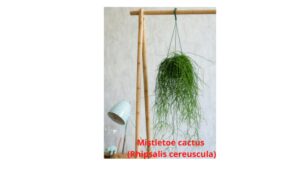
Mistletoe cactus (Family: Cactaceae ) is a shrubby cactus and epiphytes in nature. Epiphytes mean this plant is grown on the surface of other plants and never damages them in any way. It gets moisture and nutrients from its surroundings. This plant doesn’t require direct sunlight because it can burn its leaves and easily grow in low light. This plant needs regular watering to thrive although overwatering is to be avoided as it can cause root rot.
Origin
Central America, Caribbean, South America
Common names
Mistletoe cactus, current cactus, old man’s beard, pencil cactus, spaghetti cactus, coral cactus, epiphytic cactus, rice cactus.
Botanical description
This cactus has a cylindrical, pencil-thin stem and skinny, finger-like leaves. This plant can grow up to 3 feet long with small rice-shaped joints. These cactus produce bell-shaped creamy-white flowers. The fruits of this plant are also edible, with a soft sweet taste.
How to propagate
Mistletoe cacti can be easily propagated using stem cuttings. Place the cutting for a few days to allow it to dry and then place it on the well-draining soil to root.
How to care
Light
This plant needs plenty of indirect light or morning light a day. It can be placed near a sunny window (South or West facing) indoor to obtain the best growth.
Soil
It prefers well-drained potting soil with 1 part of sand for added growth.
Water
Mistletoe cacti need a moderate amount of water when the soil is dry and reduce watering in the winter. Water thoroughly, then allows the soil to dry slightly between watering.
Fertilizer
Fertilize about once a month with a water-soluble fertilizer during the spring and summer only.
Christmas cactus (Schlumbergera bridgesii)
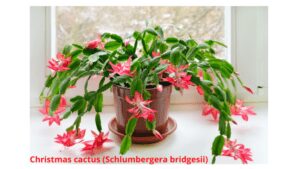
Christmas cactus (family Cactaceae), is one kind of low light succulent that is usually grown as flowering houseplants. They grew primarily for autumn and winter sales and bloomed indoors about Christmastime. This plant is also known as Epiphytic Cactus (surface growers), those plants which live on other plants. Christmas cactus care is easy and produces attractive flowers.
Origin
Coastal Mountains of southeast Brazil.
Common name
Forest cactus, Christmas Cactus, True Christmas Cactus, Holiday Cactus, Link Cactus, Grandmother’s Cactus.
Botanical description
Christmas cactus has dark-green flattened stems which are joined one on to the other. Flower blossoms at the tips of the stems. The flower of this plant has a beautiful red, pink and white color. The stems of Schlumbergera form joints that can be flat, leaf-shaped, or bottle-shaped. The stems are green all year round. Christmas cactus has dark-green flattened stems (leaf-like) that are joined by glossy green segments. These leaves have rounded teeth on the margins of the leaves. The hanging branches can grow up to 3 feet long. Flowers emerge at the tips of the stem. This flower is available in red, white, golden yellow, pink, or purple (7).
How to propagate
Christmas cactus can be easy to propagate by stem cutting in sandy soil. If the base of the plant becomes woody, it’s a great sign because it helps to create more Christmas cacti.
How to care
The Christmas cactus blooms for a long time indoors in indirect sunlight or low light. This plant is easy to care for and propagate thus perfect for the living room.
Soil
This plant requires well-drained soil that is rich in humus.
Water
It requires some humidity for better growth; water it a little more often than normally water succulents.
Light
Christmas cacti do well in partial shade or bright indirect light (medium to low light) because too much light burns its leaves.
Fertilizer
Apply a liquid fertilizer every 2 weeks and a low amount of vermicompost every 3 months are good for blooming.
Temperature
This plant grows well at normal room temperature but it can tolerate low to high temperatures as well.
Repotting
Repotting of Christmas cactus should be done in 1-2 years in spring or early summer after blooming.
Bear’s paw (Cotyledon tomentosa)
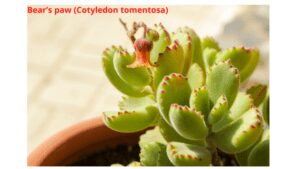
Bear’s paw (Family Crassulaceae) is an evergreen shrubby succulent that has thick, bear’s paw-like leaves and densely branched stem. This plant needs very little care and can easily grow in low light.
Origin
South Africa
Common names
Bear’s claw plant, bear’s paw succulent, bear paw cactus, and kitten paw plant.
Botanical description
The leaves of this plant are gray-blue in color, velvet-to-the-touch, and with deep red teeth (3 to 10) at its tips. The flowers are shaped like bells and orange-red. This plant can grow up to 1-2 feet tall in pots (8).
How to propagate
There are various ways to propagate this plant such as by cutting, leaf and seeds. Although, the propagation using leaves is difficult because they contain too much water.
By stem cutting
This is the easiest way of propagation in which the stem is at least 15 cm long. Remove some of the leaves and allow them to dry for a few days until to form a callous. Place them in fast-draining soil and wait for roots to develop.
Propagation by leaf
Take the leaf from the stem and allow it to be callous for a few days. Place them in a container with well-drained soil after a few days to weeks the roots are growing out.
Propagation by seeds
Place seed during autumn on the soil. Keep moist, and they will germinate in a few weeks.
How to care
Light
This plant doesn’t tolerate too much direct sunlight, they do well near the window to get indirect sunlight.
Soil
Plant the bear’s paw plant in well-drained sandy soil for best growth.
Water
Like succulents, this plant requires watering only when the top of the soil is dry. Once your plant is dry, water it thoroughly and remove excess water because it may cause root rot. Reduce watering during the dormant winter period.
Fertilizer
Fertilize the plants with water-soluble fertilizer twice a month from April to August.
Burro’s Tail (Sedum morganianum)
 Burro’s Tail (family Crassulaceae) is a flowering succulent. It has trailing stems which makes it perfect for a hanging plant. This is a drought-resistant plant that easily grows in low light and requires minimum maintenance. This plant stores a high amount of water in its leaves which makes this plant weigh very heavily.
Burro’s Tail (family Crassulaceae) is a flowering succulent. It has trailing stems which makes it perfect for a hanging plant. This is a drought-resistant plant that easily grows in low light and requires minimum maintenance. This plant stores a high amount of water in its leaves which makes this plant weigh very heavily.
Common name
Donkey tail, horse’s tail, lamb’s tail
Origin
Southern Mexico and Honduras
Botanical description
This plant produces a thick trailing stem that can grow its tail 4 ft tall. The leaves are fleshy blue-green or grey-green and smooth-textured. These leaves are lance-shaped, and overlapping grows in a spiraling pattern encircling the stem, which almost creates braided. This plant produces small, star-shaped, terminal pink to red flowers in summer but rarely indoor (9).
How to propagate
This plant is easy to propagate through its leaves and stem cutting. Simply put the leaves into a new pot filled with cacti or succulent soil mixture and wait until roots will develop.
For stem cuttings, remove the leaves from the lower end of a cut stem; allow it to dry for a few days. Place them in fast-draining soil and wait for roots to develop.
How to care
Light
This plant does not require direct sunlight because too much sunburn its leaves and becomes yellowish to pale green color. However, insufficient light may cause longer internodes, so it grows well in indirect filtered light or near the window.
Water
No need to water regularly, irrigate only when the topsoil dries completely. Suspend watering during the dormant winter period.
Soil
Plant into pots using cacti succulent soil mix or well-drained sandy soil.
Fertilizer
Fertilize only once or twice during the growing season.
Temperature and humidity
This plant prefers 65 to 75 °F for best growth and does so well in normal room humidity.
Repotting
Repotting of this plant is tough due to the fragile nature of its leaves. Remove the plant when the soil is completely dry and place it in the bigger pot with fresh soil. Repotting should be done in spring and once planting it should be kept in full sun for a few days.
Gasteria (Family: Asphodelaceae)
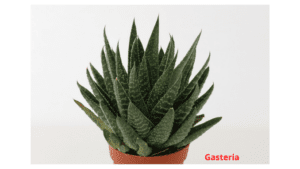
Gasteria (Gasteria spp.) is a group of eye-catching and slow-growing succulents that can make an excellent choice as houseplants. Depending on the species, the leaves of this plant are often marked with interesting patterns and colors. In comparison to many other succulents, this plant can easily thrive in low light conditions and require little maintenance. In the winter to spring this plant produces tubular, curved flowers which resemble the shape of a stomach. With time, this plant will produce offsets and grow in a clumping or mounding formation.
Origin
South Africa
Common names
Ox tongue, cow’s tongue, lawyer’s tongue
Botanical description-
Plant type
succulent perennial
Size
Around 6″ – 20” inches depending on the variety
Leaves
This plant has long, thick, dark green, irregular in touch, and closely packed leaves. These leaves are variegated with white raised bumps in the center of each leaf. Moreover, white, bumpy, raised margins present around the round-edged leaves.
Flower
It produces flowers in clusters that form on the end of a long stem or spike. These flowers are tubular, bulbous with an inflated base and orange-red green tips (10).
How to propagate
Depending on the species it is propagated using offsets, seeds, or by leaf. They can be propagated during repotting because it produces various offsets (daughter plants). These offsets can separate from the mother plant and replant it in potting soil.
How to care
Light
This plant needs low-light or filtered light but not direct sunlight because it may cause yellow or white leaves.
Soil
Gasteria likes well-drained sandy soil or cactus mix.
Water
This plant requires water when the top few inches of soil are dry. Water thoroughly; allow the soil to dry between watering. Reduce watering in the winter.
Fertilizer
Fertilize the plant with a water-soluble cactus fertilizer during the growth phase.
Temperature
This plant-like warm summers and slightly cools winters, down to 50 ˚F (10 ˚C).
Aloe vera (Aloe barbadensis Miller)
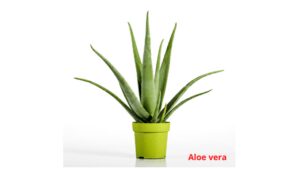
Aloe vera (family Liliaceae) is the most popular herb in the world. It can be consumed in various forms such as tea, gel, juice, salve, capsule, and decoction. Due to its versatile benefits, it is best as a houseplant because it needs no care and does well in low light.
Origin
Arabian peninsula
Common names
Chinese aloe, first-aid plant, burn aloe, Indian aloe, Barbados aloe
Botanical description
Plant size
This plant grows up to 1-2 feet and wide.
Stem
This plant is stemless
Leaves
They have thick, fleshy, green to bluish-grey-green leaves. The margin of the leaf is serrated with small teeth (11).
How to propagate
A mature healthy plant will eventually produce offsets in the base of the plant. Separate the offshoots, from the mother plant and replant them in well-draining soil.
How to care
Light
Bright indirect light is best for the plant because the direct sun can burn the leaf. In a low-light area, keep them near the window for some time.
Water
Like other succulents, this plant requires watering only when required and lets the soil dry out completely between watering.
Soil
Well-drained Soil or cactus potting soil is good for growth.
Fertilizer
Fertilize the plant once a month or during summer to obtain the best growth.
Humidity/Temperature
This plant prefers dry air so no extra humidity is needed. It does well in temperatures between 55 and 80°F (13 and 27°C).
Repotting
Aloe vera contains a shallow root system so put in a wider pot, rather than a deeper one.
Q&A
Where to buy succulents low light?
Succulents have become super popular over the last few days. In which low-light succulents do not need extra care and also thrive in a normal home environment. It is easily available at garden centers and online.
Which succulents are the heartiest in low light?
Some species of succulents grow well in low light and many species can tolerate it. Some plants such as snake plants, panda, jade, zebra plant, Christmas cactus, etc. grow well in low light.
What succulents do well inside low light?
Depending on the species, the exact amount of light needed by an indoor succulent will vary. Some succulents cannot tolerate direct sunlight (may cause sunburn) whereas others grow well in low-light environments. Moreover, in comparison to outdoor, the indoor plant has more control conditions such as light, temperature, humidity, etc. This controlled environment is beneficial for that plant that is difficult to grow.
